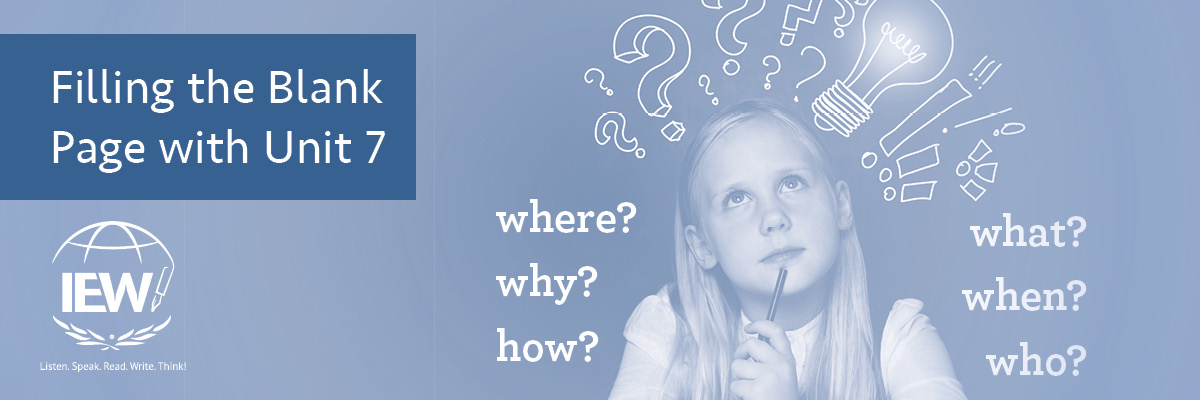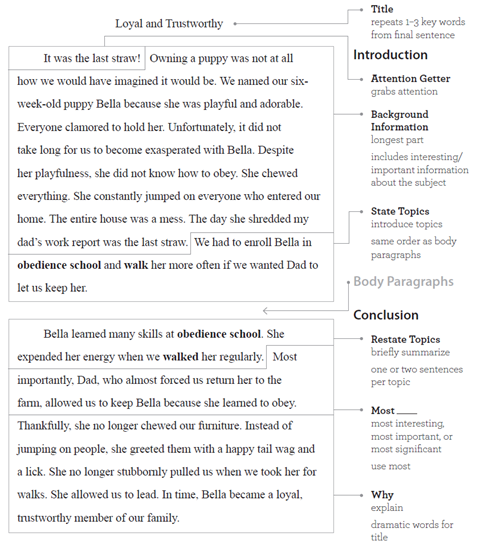
IEW teaches students to write with structure and with style. Style includes vocabulary. Structure is the elements found in compositions. Throughout the year students progress through nine structural units.
At this point in the blog series, we have covered Unit 1 through Unit 6. The basics have been taught, and students are now equipped to face the blank page with a well-stocked writing toolbox.
Unit 7 is titled Inventive Writing. Inventive is derived from the Latin root invenio, which means to invent. While inventive refers to creativity and to the ability to come up with ideas, inventory, a related word, refers to the stock of goods or materials available at a particular time. Writing from a blank page requires that students take stock of the information in their brains to come up with ideas.
By following a defined process, students can tackle any blank page writing assignment with ease.
1. Determine the subject.
All writing assignments begin with the subject, the thing the entire paper is about. A prompt often provides the subject.
2. List possible topics.
A topic is a division of or thing within the subject. If the subject (paper) is about a pet, the possible topics (paragraphs) may be obedience school, walks, grooming, fetch, or chewing. If the subject (paper) is about a recent vacation, the possible topics (paragraphs) may be flight, hotel, beach, meals, excursion, or jet ski.
3. Choose topics.
Students choose the number of topics based on the length of the assignment. While every paper is about one subject, each body paragraph is about a single topic related to that subject.

4. Write the key word outline (KWO).
Students begin by writing words on the Roman numeral line, following the topic line pattern: subject, topic, one more word about the topic. If the assignment is to write about a pet, the key words on the topic line of the KWO for the first paragraph may be Bella, obedience school, fun.
The KWO is completed by asking good questions: questions that were first taught in Unit 3 and expanded in Unit 5. By asking questions and providing answers, students take an inventory of the information they know about a particular topic: obedience school is fun.
What did Bella learn?
What did you learn?
When was obedience school?
What was fun?
What did Bella do?
How did you train her?
The answers to the questions become the details for the outline. As students answer each question, they write two or three key words on each line of the KWO and use symbols, numbers, and abbreviations when possible.
5. Write the body paragraphs.
Using their key word outlines, students write the body paragraphs. Each paragraph begins with a topic sentence that tells what the paragraph is about, contains facts that support, prove, or illustrate the topic, and ends with a clincher sentence that repeats or reflects key words from the topic sentence.
6. Write the conclusion.
To avoid writers’ block, students should write from the inside and work their way out. After the body paragraphs are complete, students write the conclusion. Since a conclusion does not contain new information, it is easier to write than the introduction.
A conclusion begins with a restatement of topics, summarized in one or two sentences each, and then indicates what is most important about the subject and why. The conclusion also brings finality to the paper.
7. Write the introduction.
An introduction must get the readers’ attention by enticing readers to keep reading. An attention getter may be a question, a dramatic fact, or a quotation. The majority of this paragraph introduces the readers to the subject of the paper. In essence, the introduction prepares the readers for the information to come. In our example the author would introduce the reader to Bella, the pet. A brief description would suffice. The introduction ends by stating the topics.
These sample paragraphs are from Frontiers in Writing.

Students can use this process to write a letter, to complete a college application, to write an article for a newsletter, or to draft a cover letter.
Since writing is a learnable skill, it is important to provide plenty of practice for your students. The IEW Writing Contest, which is currently in progress, is a great opportunity for your students to apply their writing skills. Find more details at IEW.com/IEW-writing-contest
by Heidi Thomas
Originally posted on April 11, 2024
